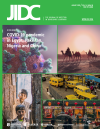Characteristics of HIV-positive pregnant women and HIV- and antiretroviral therapy-exposed fetuses: A case-control study
DOI:
https://doi.org/10.3855/jidc.11745Keywords:
pregnancy, fetus, HIV, AIDS, antiretroviral therapyAbstract
Introduction: This study determined risk factors, obstetric comorbidities, and fetal conditions among HIV-positive mothers to improve their maternal care.
Methodology: This retrospective case-control study included HIV-positive pregnant women 18 years of age or older and age-, parity-, and delivery method-matched HIV-negative controls between 2011 and 2018. Those who had stillbirth were excluded. Baseline demographics, labor process, CD4 count, plasma HIV viral load, and antiretroviral therapy (ART) regimen were recorded. Fetal conditions were recorded as well.
Results: Forty HIV-positive women (45 parities; 22 via NSD, 23 via C/S) were included, with 45 HIV-negative parities as controls. Twenty-nine (72.5%) HIV-positive women had illicit drug use. In the HIV-positive group, 17% received ART prior to first perinatal visit, and 75.6% reached viral suppression pre-delivery. Zidovudine and ritonavir-boosted lopinavir were the majorly prescribed ART. Mild perineal lacerations via NSD were observed in HIV-positive women. Fetal body weight was lower in HIV- and ART-exposed fetuses (2665 vs 3010 g, p < 0.001). Preterm delivery PTB (28.9% vs 8.9%, p= 0.015) and small-for gestational age SGA (28.9% vs 8.8%, p = 0.003) rates were higher in the HIV-positive group. There was no vertical transmission of HIV.
Conclusions: HIV-positive women tend to deliver fetuses with low body weight and have higher SGA and PTB rates. Given that most women received zidovudine and protease inhibitors, benefits of newer agents for HIV-positive pregnancies should be studied.
Downloads
Published
How to Cite
Issue
Section
License
Authors who publish with this journal agree to the following terms:
- Authors retain copyright and grant the journal right of first publication with the work simultaneously licensed under a Creative Commons Attribution License that allows others to share the work with an acknowledgement of the work's authorship and initial publication in this journal.
- Authors are able to enter into separate, additional contractual arrangements for the non-exclusive distribution of the journal's published version of the work (e.g., post it to an institutional repository or publish it in a book), with an acknowledgement of its initial publication in this journal.
- Authors are permitted and encouraged to post their work online (e.g., in institutional repositories or on their website) prior to and during the submission process, as it can lead to productive exchanges, as well as earlier and greater citation of published work (See The Effect of Open Access).








